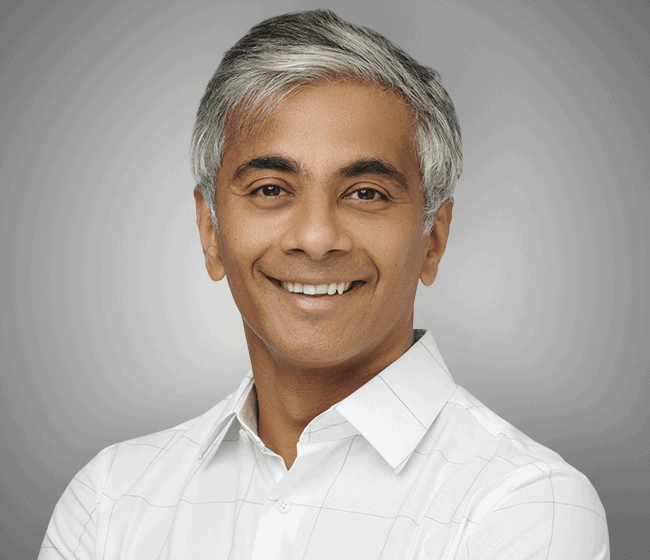Vivek Ramachandran, HSBC’s head of Global Trade and Receivables Finance, speaks to Global Finance about the post-pandemic challenges and opportunities facing treasurers.
With the supply chain shocks that followed the global Covid-19 outbreak, working capital, trade and trade finance, and the business models that support them have become top-of-mind issues for top management and made treasury’s role in managing these far more critical. Trade “is now a topic that you can talk to CEOs about,” says Vivek Ramachandran, head of Global Trade and Receivables Finance at HSBC, the largest global trade bank with access to almost 90% of the world’s trade flows. “It’s strategic, and not because of the financing; it’s strategic because it impacts your business model.”
Consumer demand remains weak in most developed markets, and critically, has failed to rebound in China, Ramachandran notes; this puts pressure on companies through smaller or delayed orders and shorter order cycles as they destock after several years when inventory built up. Higher interest rates, too, are impacting the trade cycle and dampening companies’ confidence, he says, prompting businesses to cast a more discerning eye on both prospective investments and how they manage working capital.
Global Finance: While some economies, notably the US, have been recovering rapidly, progress has been mixed overall. Do you expect the current choppy environment to continue?
Ramachandran: We are likely to see these macro conditions continue through this year and potentially into next year. The Purchasing Managers’ Index and Supply Chain Pressure Indexes reflect the toughest market for trade in several years—and this is affecting most sectors.

GF: How does this affect treasury day-to-day, in its role managing working capital, supply chain, and trade finance? And do you see a change in the role that treasury expects its trade bank to play?
Ramachandran: Today, it’s not just about the financing, but about risk mitigation. And it’s not just about financing at the point of trade, but also pre-shipment. HSBC has 5,000 professionals working across our global trade business, and what we do as a team is incredibly important in helping our clients to fulfil their ambitions. One of the many things that makes us so unique is the extent of our networks; we are most likely to bank both the buyers and their suppliers. That visibility into trading relationships places us uniquely to mitigate risks, and to finance earlier in the production process.
It is a hugely important time for us to stay close to our customers, to listen to what’s happening to them, and to bring best practice to them from around the world. Our meetings with clients always involve a two-part exchange, where we listen to what’s happening to them and then share with them what other clients in other industries and markets around the world are doing.
India, for example, is going through a digital revolution, and there are pockets in China where some incredibly inspiring work is being done within platform-based financing. We are spending a lot of time cross-pollinating these kinds of ideas.
GF: What can treasurers do to ensure they are helping their companies keep up with the current challenges and support further growth?
Ramachandran: I have yet to meet a company, large or small, that is not leaving value on the table when it comes to working capital optimization. Even the industry’s best players are only doing it in pockets; no one is doing it consistently. So, the first point is about conducting a yearly in-depth examination of working capital, understanding best practice, and being open to new ideas.
The second opportunity is in using sustainability as a differentiator. If you’re not doing it on your terms, you’re going to be asked to do it on somebody else’s. So, make sure that if you are investing in it, advertise it to your buyers and suppliers. They’ll use it to differentiate themselves.
The third is to embrace new business models: selling on platforms; selling directly to your consumers (and that might be a business); evolving your business model and thinking about financing to incentivize buyers and sellers on this new business model. Financing should not be an afterthought; embed financing in your journey as you adapt and build new business models.
The fourth opportunity is to look beyond the markets you’re in. In addition to India, there is huge opportunity in Vietnam and in Mexico. Companies tend to look at countries they’ve historically traded with. Start thinking global.
Finally, talk to us! Whilst we may not have the answer, we will definitely have seen other companies dealing with similar issues.
GF: How is HSBC leveraging data and technology to optimize financial flows in the supply chain and otherwise help treasury improve trade finance outcomes?
Ramachandran: Our greatest area of focus is on leveraging insights from data. Our goal is to interrogate the data we have from our relationships with companies to establish how we can lend earlier in the production process or support customers with their suppliers. That’s really more about digital or parametric decision-making.
With the new investments that we’ve made in HSBC’s trade systems, which I think is a genuine game-changer in automating and digitizing trade services, we can now play back valuable insights to customers. Our emphasis is on this end-to-end automation of processes, so we can remove human error and reduce costs for clients.
Whilst buzzwords are exciting, we are not yet using artificial intelligence in the trade business at present. When we do anything with client data, HSBC is always very cautious. For now, we are only experimenting with AI.
GF: What are the greatest changes you have seen over your 25 years in global cash and trade finance?
Ramachandran: The single biggest shift that I have seen has in fact taken place over the last three years, and it is that trade is no longer considered a back-office activity.
The second major shift is that technology is now at the heart of what we do as a bank. When I joined HSBC as global head of product, the skill you had as a product manager was understanding the customer and understanding risk. Now, you need to understand technology, as it’s fundamental to what we do.
Additionally, the design element of the customer journey—the user interface and experience—has gone from being a back-office and an operationally heavy job to being a lot more exciting today.
I am obviously biased when I say this, but if you care about technology, trade is a great place to be; if you care about sustainability, it’s an amazing place to be; and if you care about risk management, risk mitigation and new solutions, I think that in the next five to ten years, we are going to see an amazing amount of change in inventory finance and embedded finance solutions.



